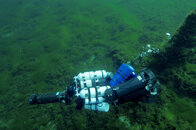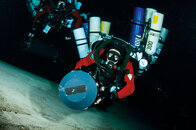Guys, you are way overthinking this. You are planning as if you are solo diving and tech diving at the same time, which is not necessarily the case. You talk about redundancy as if your wonderful, shiny new regulators are going to conk out on you at any time. Is that a remote possibility? Now, maybe, as these regulators have gotten very, very complex compared to the regulators of old. If you haven’t seen it, your should watch the Cousteau video about finding the Britannic. Yes, they used some rather advanced techniques and weren’t solo diving; they were tech diving with a triple tank system at 300 plus feet though. Why could they accomplish that? Well, they Mistral double hose regulator they used had six moving parts—that’s all. Take a look at the video:
Now, if you are diving solo using recreational rules (no decompression diving, no overhead environment, to caves, etc.), there is no reason for this redundancy, You can just swim to the surface. I have been diving this way for over 50, mostly solo. I usually have some redundancy, sometimes using double tanks, but not always. I have a Sherwood manifold that has twin posts, and a newer Scubapro manifold with twin posts. But this is so I can used my vintage double hose regulators with a single hose regulator that has LP and HP ports. But there are numerous times that I dive a small twin set with only a Mistral or Healthways Scuba regulator (both basically the same single stage design, with six moving parts). I have never had a failure. On several of my twin tank sets, I have a J-valve that I use with these regulators, just as I was taught to do in the U.S. Naval School for Underwater Swimmers in 1967.
Whenever you load up your gear with redundant gear, you are compromising your swimming ability. You have much more resistance to swimming in the water, which leads to more redundancy and a dive scooter (or two or three, according to the above photos

).
I have made a study of underwater swimming techniques, and those skills have deteriorated over the last two or three decades amongst most divers. Why? Well, the so-called “frog kick” is one reason, but the other is loading one’s self up with redundant, but very in streamlined, gear. Dry suits also have contributed to the loss of swimming ability of divers, again due to their excess drag.
Just a few things to think about.
SeaRat
 Subtidal Clambed Survey006
Subtidal Clambed Survey006 by
John Ratliff, on Flickr
How I dove in the 1970s, with a BCD built into the back of my wetsuit, and a CO2 vest for surface emergencies. I also used a full-face mask at times with my double hose reguator (one only). The weights are built into the Mar-Vel backpack. (Note also that I had hair on top back then.

. )
 John Photos003
John Photos003 by
John Ratliff, on Flickr
Diving solo in Alexander Springs State Park, Florida in 1970, with only our PJ jump tanks and a Mistral regulator with a J-reserve.
 JCR & Aqueon
JCR & Aqueon by
John Ratliff, on Flickr
Studying swimming techniques and ability with the Aqueon in Lake Chalan, Washington, 1972. Note how streamlined I am.
 fullsizeoutput_29b4
fullsizeoutput_29b4 by
John Ratliff, on Flickr
This is perhaps the most advanced scuba unit I own, which has a Scubapro twin post manifold, a Mk V/A.I.R. I regulator and a Mk VII/Pilot regulator. Talk about redundancy; but they are not isolated. And, I have about a 350 psig sonic reserve on the Mk VII. I also use this combo with a Mistral double hose regulator on the center post.










